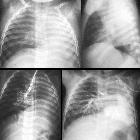Isolated unilateral absence of pulmonary artery













Isolated unilateral absence of the pulmonary artery (IUAPA) is the congenital absence of the left or right pulmonary artery. When found in combination with other congenital vascular abnormalities it is known as unilateral absence of the pulmonary artery (UAPA).
Epidemiology
Unilateral absence of the pulmonary artery (UAPA) is a rare clinical condition affecting <0.3% of the population. Isolated unilateral absence pulmonary artery (IUAPA) accounts for 40% of such cases.
Clinical presentation
Isolated unilateral absence of pulmonary artery (IUAPA) is often associated with congenital heart conditions and usually diagnosed in early childhood. IUAPA may also present in adults with the following symptoms:
- dyspnea
- reduced exercise tolerance
- chest pain
- pleural effusion
- recurrent bronchopneumonia
- hemoptysis
- high-altitude pulmonary edema (HAPE)
- respiratory difficulty during pregnancy
- asymptomatic and found incidentally (30%)
Pathology
Isolated unilateral absence of pulmonary artery (IUAPA) is thought to be due to failed migration and rotation of the primitive sixth aortic arch resulting in agenesis of the pulmonary artery.
The pathogenesis of recurrent bronchopneumonia is thought to be due to hypoperfusion, V-Q mismatch, reduced mucosal defense, and possibly protease-antiprotease imbalance. Hemoptysis is caused by excessive collateral circulation.
Associations
Whilst isolated unilateral absence of pulmonary artery (IUAPA) is not associated with other clinical conditions, UAPA may be associated with the following vascular abnormalities:
- tetralogy of Fallot
- coarctation of the aorta
- ventricular septal defect (VSD)
- subvalvular aortic stenosis
- transposition of the great arteries (plus VSD or pulmonary stenosis)
- Taussig-Bing malformation and coarctation
- congenitally corrected transposition and pulmonary stenosis
- scimitar syndrome
Radiographic features
Plain radiograph
- ipsilateral contracted lung / small hemithorax
- mediastinal and tracheal shift toward the affected side
- ipsilateral hemidiaphragm elevation
- absent hilar shadow / pulmonary artery
- ipsilateral diminished pulmonary vascular markings
- contralateral lung hyperinflation and prominent pulmonary artery
- absent air trapping on expiratory film
Echocardiography
- absence of the artery
- pulmonary hypertension
- associated cardiac anomalies
CT/MRI
- diminished pulmonary vessels
- bronchiectasis secondary to recurrent bronchopneumonia
Nuclear medicine
On V-Q scintigraphy (quantitative):
- absent perfusion to the affected side
- useful for distinguishing IUAPA from Swyer-James-McLeod syndrome
Angiography
- absence of the pulmonary artery
- presence of the pulmonary trunk and contralateral pulmonary artery
Right heart catheterization
- pulmonary capillary wedge pressure
- pulmonary capillary wedge angiography (looking for hidden hilar arteries)
Complications
- pulmonary hypertension
- right heart failure
- bronchiectasis
- high altitude pulmonary edema
- pulmonary hemorrhage
Treatment and prognosis
Treatment options include:
- revascularization surgery
- pulmonary vasodilator therapy (for pulmonary hypertension)
- pneumonectomy or lobectomy
- embolization of collateral hemorrhage
Pulmonary hypertension and hemoptysis confer a poorer prognosis.
Differential diagnosis
On imaging consider:
Siehe auch:

 Assoziationen und Differentialdiagnosen zu unilaterale Pulmonalarterienatresie:
Assoziationen und Differentialdiagnosen zu unilaterale Pulmonalarterienatresie:

